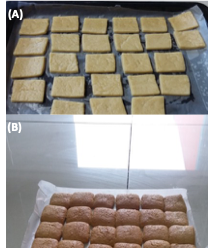 |
|
Cookies from wheat flour are one of the most consumed bakery products. As they are deficient in fiber, usually other ingredients are added to improve the organoleptic and nutritional attributes. In this work, three formulations were followed to prepare wheat flour (WF) cookies with pineapple flour (PF) at 5, 10, and 15% of substitution. The acceptance level of the cookies was analyzed by three consumer groups: children, teenagers, and adults. The physicochemical properties and shelf-life were also evaluated. Cookies containing 15 % of PF reached a 16 mg GAE/100 g of total polyphenols. The content of antioxidants remained at acceptable levels after baking. The proximal analysis showed that the ash, fiber, and protein contents in all treatments were significantly higher (p≤0.05) than that of commercial samples. Cookies with 5% PF had the highest level of acceptance in the three consumer groups evaluated. The cookies maintained the sensory characteristics after four weeks of storage. The organoleptic and nutritional properties of the cookies were improved after adding pineapple flour. Replacing what flour by 5-15% pineapple flour allowed obtaining cookies with an adequate content of protein, fiber, and total polyphenols.
Keywords: cookies, total phenols, fiber, texture, acceptability.
|
|
 |

